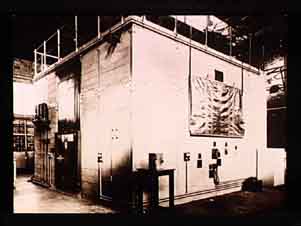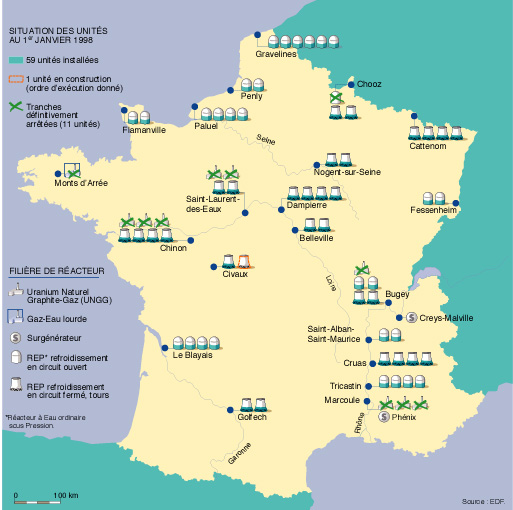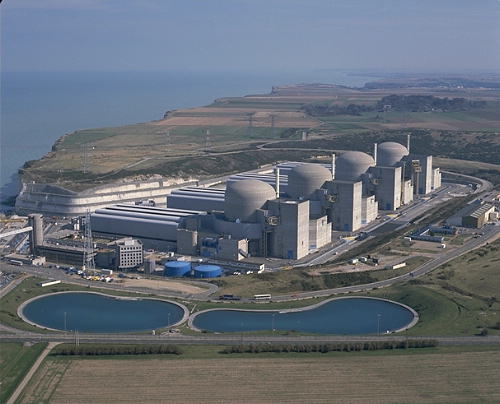Producing energy from nuclear fission
The world’s first nuclear reactor was completed in 1942, and housed under the stands of the Chicago University stadium. Under these stands was built, in the greatest secrecy, an edifice made of graphite and natural uranium which was given the name of atomic pile, because it was a real pile of graphite bars, some of which hollow containing uranium. Graphite served as a moderator, uranium as nuclear fuel. This atomic pile, designed by a team of physicists led by the Nobel Laureate Enrico Fermi, diverged (chain reactions occurred) on December 2, 1942.
Over the following years, several reactors were built in Washington State – in the desert environment of Hanford – with the aim of producing enough plutonium to build the first atomic bombs. Onboard reactors for submarine propulsion were then put into service with the launch in 1954 of the world’s first nuclear submarine, NAUTILUS. It was not until the 1950s that reactors were designed for civil purposes to produce electricity. Developed as part of President Eisenhower’s Atoms for Peace program (1953), they are heirs to the naval propulsion reactor prototypes.

The Zoé pile
The first sustained chain reactions at the Zoé reactor of Fort Châtillon (south of Paris) took place on December 1948. Symbol of the French atomic effort after the Second World War, Zoé, the first nuclear reactor in France, can still be visited today.
© CEA
A peaceful use of the atom
In 2014, there was over 437 nuclear reactors in activity worldwide, all distant descendants of Fermi’s atomic pile and the nuclear reactors of Hanford. Many modern reactors have an electrical power of 1 gigawatt each. They have a combined output of 350 GW, producing 17% of the world’s energy supply. The part that nuclear energy plays, however, differs from country to country. In Europe, for instance, France and Belgium are both heavily reliant on nuclear energy (in France, nuclear energy makes up 75% of the total supply), whereas England (35%) and Germany (33%) use far less. Italy’s four power plants were shut down after Chernobyl, and the country currently obtains 0% of its energy from nuclear processes. Outside Europe, the resource-rich United States have little need for nuclear energy, but in Japan, a country comparatively poor in natural energy sources, 33% of the energy is supplied by nuclear reactors. Asia is home to the two countries currently most heavily reliant on nuclear energy for their development: Korea and China.

Map of french nuclear plants
This map shows the implantation of the French nuclear plants in 1998. Overall, 59 units (or tranches) of pressurized water Reactors were in activity in 2005. Eleven units (Bugey, Chinon, Saint-Laurent-des-Eaux, Marcoule et Chooz), belonging to the first generation of graphite-gaz reactors using natural uranium (UNCC) have been definitively closed. SUPERPHENIX, the breeder reactor at Creys-Malville have been closed in 1997, but its predecessor PHENIX at Marcoule still runs for researches and development.
© Source EDF
Nuclear energy is mainly released by conventional reactors of the so-called ‘second generation’, which use natural uranium (enriched with 3-4% of uranium 235) as a fuel source. Older reactors of first generation, which used unenriched uranium, had to have heavy water or graphite to slow the neutrons down. Today’s reactors, however, can use ordinary water both to slow the neutrons down and to serve as a coolant.
There are two types of second generation reactors that are based on enriched uranium: those that use boiling water and those using pressurized water. In Europe, almost 80% of reactors are PWRs (Pressurized Water Reactors), by far the most common design worldwide. Recent advances in the processing of nuclear waste have also allowed for the recycling of plutonium extracted from the spent fuel, leading to increased energy production per ton of uranium.

Paluel reactors
This photograph of the Paluel nuclear plant in Haute-Normandie shows how technology has improved over the 40 years since Zoé. Comprising four large reactors, each unit with a combined power of 1.3 million kilowatts, this plant showcases the mastery of PWR technology acquired since the 1950’s.
© LA MEDIATHEQUE EDF / MARC MORCEAU (1990)
Reactors using fast neutrons might be reactors of the future. They are the most efficient and attractive, since they are able to regenerate the fissile nuclei they burn. At the moment, fast neutrons are used by only a few reactors geared towards nuclear research. The French SuperPhenix was the only such reactor to reach industrial standards, but was closed down in 1997.
Articles on the subject « Nuclear Reactors »
Reactor Families
A variety of designs : Natural uranium or enriched uranium as fuel There are several industrial t[...]
World nuclear reactors
A development that takes place today in Asia At the beginning of 2014 the number of reactors in o[...]
Generation I reactors
1950-1970: First generation of reactors (50 – 500 MWe) The first generation reactors were i[...]
RBMK reactors
Soviet-era reactors at Chernobyl Cold War and the Iron Curtain led after 1947 to the development [...]
Generation II Reactors
1970-2009: the rise of nuclear energy About 85% of electricity produced worldwide by nuclear powe[...]
PWR Reactors
The most widespread type of reactor … Pressurised water reactors (PWR) are by far the most [...]
PWR Operation
High pressure water to evacuate heat and slow down neutrons The reactor core is the source of ene[...]
Boiling Water Reactors
BWR or Boiling Water Reactors Boiling water reactors or BWR are in operation in the United States[...]
Candu reactors
Canadian reactors using natural uranium and heavy water CANDU is a nuclear reactor brand develope[...]
Nuclear Propulsion
On-board reactors for submarines and aircraft carriers In addition to conventional land-based pow[...]